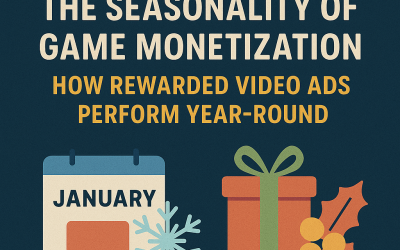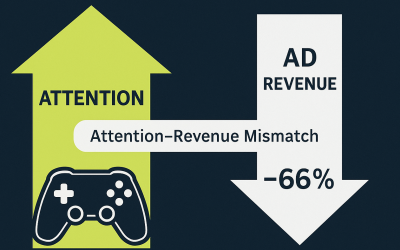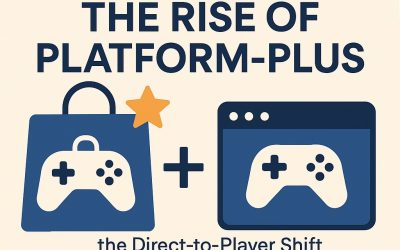Beyond Ads: Redefining Game Monetization as a Product Discipline
For much of the past decade, ad monetization in games has been treated as an afterthought—something tacked onto the player journey once design, user acquisition, and gameplay loops were already in place. The formula was simple: drop in rewarded video placements, sprinkle interstitials, and let the revenue flow.
But today, that formula is broken. Player behaviors have diversified, attention spans are fragmented, and expectations for fairness and transparency are higher than ever. Publishers who still lean on “set-and-forget” ad stacks are leaving significant money on the table—and risking player churn in the process.
The future of ad monetization will belong to those who see it not as an operational lever, but as a product discipline. That means approaching monetization with the same rigor, experimentation, and player empathy that we devote to core game mechanics. It’s about designing monetization experiences that fit the game, fit the player, and fit the market context.
Contents
The End of the Universal Model
Historically, ad monetization treated every player the same. Frequency caps, placements, and pacing were uniform. It was efficient, but it was also blunt.
This one-size-fits-all approach ignores the fact that players differ wildly in how they engage with games—and how they respond to ads. A long-session RPG player who spends hours in-game has a very different tolerance for interstitials than a hypercasual player who churns after three short sessions.
Segmentation changes the game. By tailoring ad exposure based on behavior, publishers can protect retention while unlocking new revenue streams.
Consider a few archetypes:
-
Retention-driven players: These are long-session players who return daily and often form the backbone of a community. Bombarding them with frequent interstitials risks undermining their loyalty. Instead, carefully spaced ads combined with value-added rewarded videos keep them engaged without friction.
-
Churn-prone players: These are users likely to leave within the first session or two. With them, time is limited. Earlier ad exposure—such as a rewarded video within the first five minutes—captures value before they disappear.
-
Paying users: For players who make in-app purchases, ads must feel like an enhancement, not a punishment. Rewarded ads tied to premium bonuses, or lighter ad loads, can strike the right balance.
-
Ad-first players: These users rarely spend but eagerly consume rewarded ads. In many titles, they generate a disproportionate share of ARPU. Treating them as core contributors means building ad experiences that feel like part of the game loop.
Segmentation is not about squeezing players. It’s about matching ad design to player context so that monetization supports the experience rather than undermines it.
Data as the Enabler
Segmentation only works if it’s powered by robust, actionable data. That means moving beyond surface-level metrics like impressions and CPMs and building cohorts based on:
-
Session length and frequency
-
In-game progression milestones
-
Purchase intent signals
-
Churn risk modeling
Here’s the critical shift: monetization data must no longer sit in its own silo. It should flow between three pillars—Product, User Acquisition (UA), and Monetization.
-
Product creates experiences that generate behavioral signals.
-
UA ensures you attract players who fit the game’s economy and ad design.
-
Monetization transforms engagement into sustainable revenue, feeding insights back into both Product and UA.
When one side of this triangle is weak, the system collapses. A product without engaging loops will never monetize well, no matter how advanced the ad stack. UA that drives in the wrong players creates friction that monetization can’t solve. Monetization strategies that operate without Product and UA alignment will miss opportunities or harm retention.
Data is the glue. When unified, it allows for cohort-driven design, precision UA targeting, and adaptive monetization logic.
The Role of Experimentation
Too often, experimentation stops at UA campaigns while monetization remains static. This is a missed opportunity.
Every element of ad delivery—frequency, pacing, placement, ad unit mix—should be tested, iterated, and refined. A/B testing and multivariate experiments can surface small tweaks with outsized effects. For example:
-
A casual game studio reduced rewarded video cooldown timers from 12 minutes to 8 minutes and saw 25% more ad completions without impacting retention.
-
Another title tested rewarded ads at level-completion vs mid-level, discovering that players actually preferred mid-level ads when the value was clear and immediate.
The lesson: what works for one title won’t work for another. Testing is not a one-off exercise but a core practice.
Organizationally, this means treating monetization experimentation with the same rigor as gameplay testing. It requires dedicated bandwidth, cross-functional collaboration, and the willingness to iterate fast.
Future Horizons: Where Monetization Is Heading
Segmentation and A/B testing are the foundation—but they are only the beginning. The next frontier of monetization is being shaped by three converging trends:
1. AI-Driven Personalization
With machine learning, monetization logic can move from static cohorts to real-time adaptive systems. Imagine an ad pacing engine that dynamically adjusts based on predicted churn risk, purchase likelihood, or session fatigue.
This shift could allow for hyper-granular personalization—delivering the right ad at the right moment for each individual player.
2. Privacy-First Design
The end of third-party tracking and the rise of consent-driven ecosystems (e.g., GDPR, CCPA, Apple ATT) mean publishers must rethink how they use data. The future belongs to first-party, gameplay-driven signals: how players interact with your game is more valuable—and more privacy-compliant—than any external dataset.
3. Cross-Platform Consistency
As HTML5, cloud gaming, and multi-device ecosystems grow, monetization strategies must follow players seamlessly across platforms. A user’s behavior on web should inform how they’re monetized on mobile or console, ensuring continuity in both experience and revenue strategy.
Creative Integration: Ads as Gameplay
The most exciting opportunities lie in reimagining ads not as interruptions, but as features that players choose and value.
Examples include:
-
Narrative-driven rewarded ads: Ads that tie into story arcs, offering resources that feel meaningful within the game world.
-
Ad-powered progression: Unlocking side quests, cosmetic items, or boosts through ad engagement.
-
Community incentives: Rewarding groups of players collectively when certain ad milestones are met.
These integrations blur the line between ads and mechanics, transforming monetization from a trade-off into a positive loop.
Responsibility and Trust
With greater flexibility comes greater responsibility. Segmentation and personalization can easily cross into exploitation.
For example:
-
Bombarding “high responders” with excessive ads might boost short-term revenue but destroys long-term trust.
-
Creating tiered experiences where non-payers are suffocated with ads risks alienating the very base you rely on.
The guiding principle should be simple: monetization must align with retention, not work against it. When ads feel like value, players engage. When they feel like punishment, they churn.
Responsible monetization builds trust, which compounds over time. It also positions publishers for regulatory scrutiny and brand safety concerns that will only intensify.
Organizational Shifts Needed
Ad monetization as a product discipline requires more than strategy—it requires cultural change inside organizations.
-
Cross-functional teams: Monetization cannot sit in a silo. Product, UA, and Monetization must share KPIs and collaborate on design.
-
Dedicated monetization expertise: Too often, monetization managers are under-resourced compared to UA teams. Building true expertise is critical.
-
Unified metrics: Retention, ARPU, and LTV must be tracked in tandem, not in isolation. Otherwise, short-term wins mask long-term losses.
This mindset shift is hard. But those who embrace it will outpace competitors still treating monetization as a plug-in.
AppLixir Monetization as Craft
The universal model is dead. Static placements and copy-paste best practices no longer cut it in a fragmented, competitive market. The path forward lies in segmentation, data integration, experimentation, and creative design—all underpinned by a culture that sees monetization not as an afterthought but as a core product discipline.
Publishers who embrace this approach will not only maximize ARPU but also build player experiences rooted in respect and longevity. Those who don’t will be left behind, caught in a cycle of churn and short-term thinking. Ad monetization is no longer about just running ads. It is about designing them as part of the product. And when we treat monetization as craft, we unlock value for both players and publishers alike.




